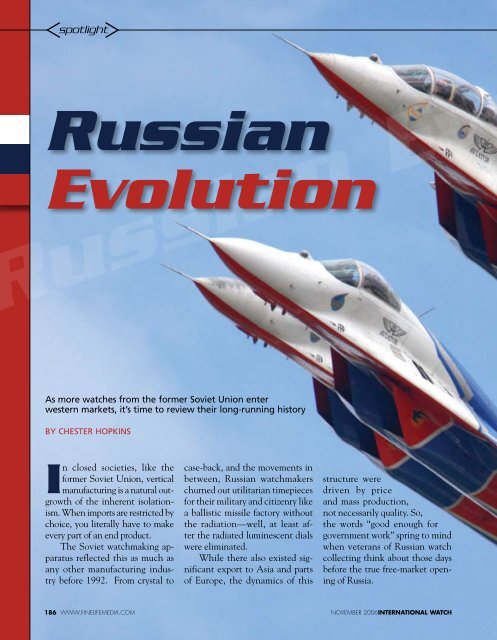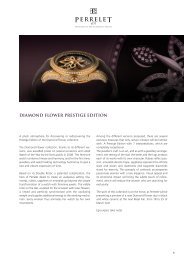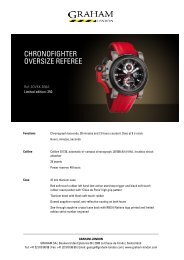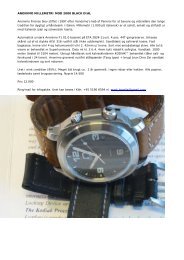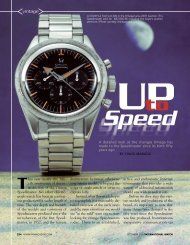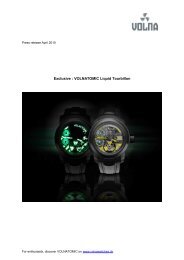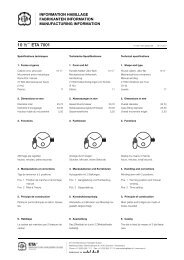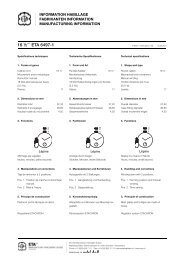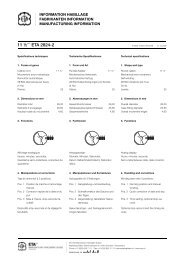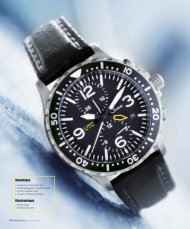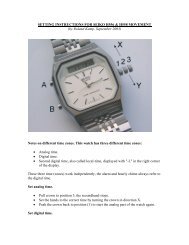You also want an ePaper? Increase the reach of your titles
YUMPU automatically turns print PDFs into web optimized ePapers that Google loves.
spotlight<br />
<strong>Russian</strong><br />
Evolution<br />
ussian Evo<br />
As more watches from the former Soviet Union enter<br />
western markets, it’s <strong>time</strong> to review their long-running history<br />
By CHeSter HopkinS<br />
In closed societies, like the<br />
former Soviet Union, vertical<br />
manufacturing is a natural outgrowth<br />
of the inherent isolationism.<br />
When imports are restricted by<br />
choice, you literally have to make<br />
every part of an end product.<br />
The Soviet watchmaking apparatus<br />
reflected this as much as<br />
any other manufacturing industry<br />
before 1992. From crystal to<br />
case-back, and the movements in<br />
between, <strong>Russian</strong> watchmakers<br />
churned out utilitarian <strong>time</strong>pieces<br />
for their military and citizenry like<br />
a ballistic missile factory without<br />
the radiation—well, at least after<br />
the radiated luminescent dials<br />
were eliminated.<br />
While there also existed significant<br />
export to Asia and parts<br />
of Europe, the dynamics of this<br />
structure were<br />
driven by price<br />
and mass production,<br />
not necessarily quality. So,<br />
the words “good enough for<br />
government work” spring to mind<br />
when veterans of <strong>Russian</strong> watch<br />
collecting think about those days<br />
before the true free-market opening<br />
of Russia.<br />
186 www.finelifemedia.<strong>com</strong> noVemBeR 2006INTERNATIONAL WATCH
lution<br />
Aviator watches, by Volmax, are the<br />
official watch of the SWIFTS – the <strong>Russian</strong><br />
equivalent of America’s Thunderbirds.<br />
Pictured here are three of their<br />
MIG 29 Fulcrums in formation during<br />
a recent show near Moscow.<br />
“We were too <strong>com</strong>placent,”<br />
says Igor Zubovskij, the managing<br />
director of Vostok-Europe, a <strong>Russian</strong><br />
watchmaker based in Lithuania.<br />
He’s referring to, or perhaps<br />
lamenting, the past culture of <strong>Russian</strong><br />
watch <strong>com</strong>panies, which lingered<br />
even for several years after<br />
the destruction of the Berlin wall<br />
and the end of the Cold War.<br />
What a difference a decade<br />
makes.<br />
In a collapse reminiscent of<br />
the Union itself, the First Moscow<br />
Watch Factory (1st MWF)<br />
and the ubiquitous Poljot Company<br />
dismantled in the 1990s under<br />
the weight of not being able<br />
to survive as it once was—essentially<br />
a mass government and<br />
proletariat supplier. While there<br />
had been significant export to<br />
Asia and Europe as well, the new<br />
open market altered forever the<br />
dynamics of this structure.<br />
Poljot<br />
At it’s zenith, Poljot, which<br />
means “Flight” in <strong>Russian</strong>, employed<br />
some 7,000 professionals.<br />
As a <strong>com</strong>parison, there were<br />
only 910 <strong>com</strong>panies<br />
in the U.S. employing<br />
more than 5,000<br />
people in 2003, according<br />
to the census<br />
bureau. Poljot was no<br />
small enterprise.<br />
Indeed, <strong>Russian</strong> watch<br />
production in general remained<br />
massive throughout the Soviet period.<br />
In 1980, Vostok—the other<br />
major name in <strong>Russian</strong> <strong>time</strong>keeping—produced<br />
4.5 million pieces.<br />
That’s enough watches for every<br />
man, woman and child in Colorado<br />
to wear the name Vostok<br />
on their wrist. Vostok itself grew<br />
from the original breakup at the<br />
1st MWF in 1942, ultimately ending<br />
up in Chistopol to escape the<br />
war’s impact on Russia’s capital<br />
city. The firm still makes watches<br />
and movements there.<br />
Out of the later splintering<br />
of Poljot, many aggressive young<br />
watchmakers emerged, develop-<br />
INTERNATIONAL WATCHnoVemBeR 2006 www.finelifemedia.<strong>com</strong> 187
spotlight<br />
Igor Zubovskij, managing director of Vostok-Europe, works<br />
at his desk in Vilnius, Lithuania.<br />
ing their own brands and learning<br />
from past mistakes. They<br />
are now truly <strong>com</strong>peting on the<br />
world stage, with interesting, notso-utilitarian<br />
designs, vastly improved<br />
quality, and prices that are<br />
remarkably affordable.<br />
<strong>Aviation</strong> history<br />
No discussion of <strong>Russian</strong> watchmaking<br />
is <strong>com</strong>plete without<br />
exploring its rich aviation and<br />
military history. Just look at the<br />
names of the brands – Aviator,<br />
Buran (which bears the name of<br />
the Soviet space shuttle), Poljot,<br />
Vostok (named for the Gagarin<br />
space orbiter) and Sturmanskie,<br />
which means “navigator,” just to<br />
name a few.<br />
<strong>Russian</strong> aerospace history and<br />
<strong>Russian</strong> watches are indissolubly<br />
connected.<br />
188 www.finelifemedia.<strong>com</strong><br />
For instance, all Soviet battle<br />
airplanes of the WWII era were<br />
equipped with the airborne clocks<br />
made by the 1st MWF. The Red<br />
Air Force pilots and navigators<br />
flew with watches on their wrists<br />
with the “The 1st MWF Kirova”<br />
and later the “Poljot” trademarks.<br />
During the Second World War<br />
even defense production—including<br />
ammunition, aviation<br />
glass, aviation clocks, navy and<br />
aviation chronometers and some<br />
parts for the first Katyusha rocket<br />
launcher—was conducted in the<br />
watch factory.<br />
But the war had not yet ended<br />
when the factory started peaceful<br />
production. In 1943 it started<br />
to make machining tools for the<br />
watch industry again, and in 1944<br />
it made fireplace, table and automobile<br />
clocks.<br />
A SWIFTS pilot walks across the tarmac wearing his<br />
uniform adorned with the Aviator watch logo.<br />
In April 1945 the factory<br />
stopped ammunition production<br />
and started preparation for a<br />
new K26 Pobeda (Victory) watch<br />
model. Production of the Pobeda<br />
with a side seconds hand started<br />
in 1946. Josef Stalin approved<br />
the name, design and specifications<br />
of this watch personally.<br />
The watch became quite popular,<br />
as the 1st MWF was making the<br />
K26 model until 1953. Today, it is<br />
still in production in other factories<br />
around the country. In 1949,<br />
the Sturmanskie (Navigator’s)<br />
watches were put into production.<br />
They were specially designed for<br />
military aviation and were not<br />
available in the general market.<br />
The 1950s<br />
By 1955, 1.1 million mechanical<br />
wristwatches were made by the<br />
noVemBeR 2006INTERNATIONAL WATCH
spotlight<br />
1st MWF. With this foundation<br />
of success they followed in 1956<br />
with production of the first <strong>Russian</strong><br />
automatic watches, under the<br />
Rodina (Fatherland) brand. With<br />
little break in speed, in 1957 they<br />
190 www.finelifemedia.<strong>com</strong><br />
developed an elite Antarktida<br />
(Antarctic) watch, under government<br />
order, for the participants of<br />
the first Soviet expedition to the<br />
South Pole.<br />
These watches were antimag-<br />
Every SWIFTS aerobatic plane<br />
carries the Aviator logo.<br />
netic with a 24-hour dial, and<br />
the watch movement was based<br />
on the Pobeda (Victory) watch<br />
movement.<br />
The Space Race:<br />
In October 1957, the Soviet<br />
Union launched the first artificial<br />
satellite into space. The whole<br />
world peered at a slightly flashing<br />
light in the night sky. To mark this<br />
event, the 1st MWF produced the<br />
Sputnik (Satellite) watch, based<br />
on the Pobeda model.<br />
Then, in 1960, the first Poljot<br />
(Flight) brand watch with the 2414<br />
caliber appeared. A Shturmanskie<br />
(then under the Poljot banner)<br />
made history on April 12, 1961,<br />
when the Soviet Union launched<br />
the first successful manned space<br />
flight and ushered in the era of<br />
space travel. Yuri Gagarin, the<br />
first man in space, wore the Sturmanskie<br />
watch on his wrist during<br />
that celebrated flight. The watch<br />
operated flawlessly in a weightless<br />
environment and became the first<br />
watch ever to go into the cosmos.<br />
Later, this legendary watch was<br />
given to the factory museum.<br />
Astronauts from France, Russia,<br />
Germany and the Ukraine<br />
took Poljot watches on space<br />
flights. The 3133 chronograph<br />
movement actually set a record<br />
for the longest duration of a space<br />
flight when cosmonaut V.V. Poljakov<br />
wore it. A <strong>com</strong>memorative<br />
edition of the Gagarin watch flew<br />
in space on the wrist of current<br />
cosmonaut Yuri Shargin in just<br />
the last two years.<br />
Cosmonauts Pavel Beliaev<br />
and Aleksej Leonov also wore<br />
noVemBeR 2006INTERNATIONAL WATCH
spotlight<br />
these watches when they became<br />
the first in the world to walk in<br />
space. During the next twenty<br />
years, 100,000 of the 3017 watches<br />
were made. The Antarktida and<br />
the Sputnik have be<strong>com</strong>e muchsought-after<br />
collectors items because<br />
they were in production for<br />
just one year.<br />
Around the same <strong>time</strong>, the<br />
Strela, another <strong>Russian</strong> watchmaking<br />
achievement, came along. A<br />
wrist chronograph with a stopwatch<br />
function and a 45-minute counter,<br />
the watch was exclusively designed<br />
for the officers of the Air Force and<br />
produced according to strict military<br />
specifications. This case and<br />
face style is still widely used today<br />
in <strong>Russian</strong> watch production.<br />
The 1970s and 1980s<br />
In 1971, the 1st Moscow Watch<br />
Factory produced 2.5 million<br />
wristwatches, and 1.6 million were<br />
exported to sixty-three different<br />
countries. In 1972, the factory<br />
increased production of mechanical<br />
wristwatches up to 2.7 million.<br />
Since up to seventy percent of the<br />
production was sold on the export<br />
market, the factory decided to design<br />
and to put into production a<br />
number of new watch movements<br />
which could satisfy the requirements<br />
of exacting foreign customers<br />
and would be useable for automatic<br />
technological processes.<br />
As a result, in 1972 new designs<br />
of watches with the 26 series<br />
caliber movement were developed<br />
and had a distinct mark of a letter<br />
“H”: 2609H, 2614H, 2616H, etc.<br />
The factory’s designers, technologists<br />
and stylists paid particular<br />
192 www.finelifemedia.<strong>com</strong><br />
Below: Vostok-Europe is the official watch to the Expedition Trophy, the longest winter<br />
off-road race in the world. Tested in these rugged conditions, each watch <strong>com</strong>es with a<br />
certificate of authenticity and reliability from Expedition Trophy and Vostok-Europe.<br />
attention to its reliability, technological<br />
aspects and reparability.<br />
In 1976, the factory started<br />
production of new wristwatches<br />
with a stopwatch function: chronograph<br />
model 3133.<br />
For this development, the factory<br />
staff was awarded with a State<br />
Bonus Reward. At the beginning,<br />
watches were intended for the<br />
Navy officers and were produced<br />
under the Okean (Ocean) brand<br />
name.<br />
Later, the factory started to<br />
make modifications intended for<br />
the Air Force, with a Shturmanskie<br />
brand name (model 31659,<br />
a watch with a second hand arrester<br />
and pointer of <strong>time</strong> zones)<br />
noVemBeR 2006INTERNATIONAL WATCH
spotlight<br />
Watch assembly line at Vostok-Europe in Vilnius<br />
and another Shturmanskie watch<br />
with a pointer of <strong>time</strong> zones (model<br />
3133). The production of these<br />
watches was limited and subjected<br />
to strict military inspections.<br />
Only nine years later, in 1983,<br />
watches with a 3133 movement<br />
were made available to the public.<br />
At the end of the 1970s and the<br />
beginning of the 1980s, the factory<br />
put into production the quartz 30<br />
series caliber watches, and later, 24<br />
and 16 calibers. The quartz movements<br />
were mainly exported to<br />
Hong Kong and Singapore. In some<br />
years, export achieved up to three<br />
to four million pieces per year.<br />
Volmax<br />
For decades, the name Poljot remained<br />
synonymous with <strong>Russian</strong><br />
watches. Outside of the Vostok<br />
<strong>com</strong>pany, (the largest and oldest<br />
continuously intact <strong>Russian</strong><br />
watchmaker in Chistopol,) Poljot<br />
held the number-one worldwide<br />
brand recognition of all the<br />
<strong>Russian</strong> watch <strong>com</strong>panies.<br />
A key player in building<br />
this brand, the Volmax Company<br />
spent years as the chief<br />
wholesale distributor of Poljot<br />
watches abroad. By 1997, how-<br />
194 www.finelifemedia.<strong>com</strong><br />
ever, it had be<strong>com</strong>e clear to<br />
Volmax that the range and<br />
quality of products provided<br />
by Poljot were actually<br />
stifling its ability to grow<br />
and expand.<br />
Knowing that Poljot<br />
could no longer <strong>com</strong>pete<br />
with the European watchmakers,<br />
Volmax made the<br />
bold move of launching<br />
its own watch production<br />
and brands. Initially they manufactured<br />
the Aviator and Buran<br />
watch lines they created for the<br />
Poljot Company. Even this proved<br />
to be burdened by the Poljot name.<br />
Then, in the year 2002, Volmax<br />
registered the trademark names of<br />
the watch lines Aviator, Buran and<br />
The 31681/6773778B Aviator.<br />
The standard bearer<br />
of the Aviator<br />
watch line. Price:<br />
$530.<br />
Sturmanskie and redefined itself as<br />
the leading watchmaker in Russia.<br />
From the outset, Volmax<br />
watches differed from other <strong>Russian</strong><br />
watch brands. Their chief goal was,<br />
and remains, to produce, market<br />
and sell their own watch brands,<br />
but to also change the generally<br />
negative attitude toward <strong>Russian</strong><br />
watches outside the borders of Russia.<br />
Unfortunately, this negative<br />
image was in many ways all too justified<br />
by poor quality control and a<br />
residual Cold War mentality.<br />
Volmax, on the other had,<br />
has strict quality and distribution<br />
control methods, and is striving<br />
noVemBeR 2006INTERNATIONAL WATCH
spotlight<br />
Gennadij Sukov, Vostok-Europe<br />
technical designer and<br />
engineer, can test as many as<br />
1,000 watches in this unique<br />
mass winder.<br />
to recapture the earlier quality<br />
and popularity of <strong>Russian</strong> watches.<br />
Volmax now <strong>com</strong>petes in the<br />
West with the best watches in the<br />
world and has the potential to<br />
break the shackles of its <strong>Russian</strong><br />
watch heritage.<br />
At first, Volmax did not fear<br />
the risk of stepping out of the<br />
price segment of the mass-production<br />
manufacturers. The firm emphasised<br />
the production of limited<br />
editions (between fifty and 999<br />
pieces depending upon the model)<br />
related to different historic events.<br />
For example, the series “100 Years<br />
<strong>Aviation</strong>” garnered much success<br />
and recognition for the <strong>com</strong>pany<br />
in 2004.<br />
The production volumes at<br />
Volmax are relatively low. “Quality<br />
and not quantity” is an oft-used<br />
motto for their efforts. Volmax uses<br />
only the best <strong>Russian</strong> movements,<br />
and puts its team together by lur-<br />
196 www.finelifemedia.<strong>com</strong><br />
ing the best designers and watch<br />
technicians in Russia from the former<br />
Poljot Company. Each of their<br />
watchmakers has many years of<br />
professional experience.<br />
Today Volmax has exclusive<br />
representations in North America,<br />
Germany, Austria, England,<br />
Portugal, Japan, Greece, Holland,<br />
Switzerland and the Baltic states.<br />
As Volmax has strengthened its<br />
position abroad, <strong>com</strong>pany leaders<br />
turned their attention to the <strong>Russian</strong><br />
domestic market for cultivation<br />
as well. At present, sales volumes<br />
abroad and in Russia are approximately<br />
equal. But two interesting<br />
trends have emerged in Russia.<br />
First, interest in classical<br />
three-hand watches continues<br />
to grow. Second, there is an increasing<br />
demand for more expen-<br />
From the Buran gold collection<br />
by Volmax, this solid<br />
18-karat open-heart<br />
chronograph retails<br />
for $5,400.<br />
sive and qualitatively higher-end<br />
watches. This indicates that Volmax<br />
products, which were regarded<br />
as exotics for collectors at the<br />
beginning, have found acceptance<br />
in the broader market.<br />
Since the <strong>Russian</strong> government<br />
does not subsidize its watchmaking<br />
industry, unlike many<br />
other countries, Volmax is forced<br />
to finance everything independently.<br />
That substantially weakens<br />
the <strong>Russian</strong> watchmaking<br />
industry on the international<br />
playing field and leaves little chance<br />
for a massive growth, which might<br />
be possible with increasing market<br />
demand.<br />
noVemBeR 2006INTERNATIONAL WATCH
spotlight<br />
Designers Konstanin Markin and Gennadij Sukov<br />
work on new watches for Vostok-Europe.<br />
Future products<br />
Volmax plans not only to extend<br />
its existing watch lines but also<br />
some interesting new projects.<br />
One is the production of a lady’s<br />
watch collection with quartz<br />
movements, emphasizing chronographs.<br />
Since there is no similar<br />
product on the <strong>Russian</strong> market,<br />
and Western customers have<br />
shown interest in this project,<br />
too, the management decided to<br />
try this experiment. Multi-functional<br />
watches are being developed<br />
as well, suitable for extreme<br />
occupations and sports. Other<br />
brand names included in the Volmax<br />
offerings include Aviator, a<br />
brand targeted at <strong>Aviation</strong> professionals<br />
and enthusiasts, military<br />
personnel and those who appreciate<br />
sports mechanical watches;<br />
Buran and Buran VM, the classic<br />
watch brand that has a traditional<br />
dress-watch appearance<br />
in the rich heritage of <strong>Russian</strong><br />
watchmaking; and Shturmanskie,<br />
a brand that represents the<br />
history of the <strong>Russian</strong> Space exploration<br />
program and militarypurpose<br />
<strong>time</strong>keeping.<br />
198 www.finelifemedia.<strong>com</strong><br />
Vostok-Europe<br />
Against a backdrop of<br />
emerging worldwide interest<br />
in <strong>Russian</strong> watches, Vostok-<br />
Europe debuted in 2003. Its<br />
striking new vision of cost<br />
effectiveness, inherent quality<br />
and the pedigree of the<br />
oldest and largest <strong>Russian</strong><br />
watchmaker quickly established<br />
the brand among European<br />
watchmakers.<br />
Since being unveiled at<br />
Baselworld in 2004, the brand has<br />
steadily grown. The cornerstone of<br />
Vostok-Europe was the marriage<br />
of the enormous potential of the<br />
The Sturmanskie “Gagarin”<br />
<strong>com</strong>memorative model<br />
worn in space recently<br />
by cosmonaut Yuri<br />
Shargin. Price:<br />
$529<br />
watch movement factory of Vostok<br />
with a groundbreaking design and<br />
a marketing philosophy focused on<br />
good quality for the price.<br />
Conceived with the intention<br />
to <strong>com</strong>pete on the level of the<br />
finest and most aggressive Western<br />
watchmakers, Vostok-Europe<br />
developed a sales and marketing<br />
strategy with an unmistakable<br />
brand identity and a style to rival<br />
anything in its category. Under<br />
the slogan “the best Soviet<br />
technologies for modern watch<br />
design,” each piece in the Vostok-<br />
Europe model line is<br />
inspired by, and<br />
noVemBeR 2006INTERNATIONAL WATCH
spotlight<br />
Vladimir Shevchenko conducts final checks and<br />
delivery control before shipping at Vostok-Europe<br />
christened with, a Soviet technological,<br />
architectural or cultural<br />
achievement.<br />
From Lithuania<br />
The seeds for this new brand<br />
were sewn in Lithuania. There, a<br />
watchmaking team in Vilnius had<br />
been building models for other<br />
major <strong>Russian</strong> brands since the<br />
early 1990s. Realizing the growing<br />
interest in <strong>Russian</strong> watches<br />
and with intent to capitalize on<br />
a vast untapped market, teams in<br />
Vilnius and Chistopol (the home<br />
of Vostok) created a joint venture<br />
of tradition and innovation now<br />
known as Koliz-Vostok.<br />
The two <strong>com</strong>panies brought<br />
together the brightest and most ingenious<br />
of the talented watch and<br />
movement designers from both<br />
bases of operation. Their collaboration<br />
resulted in the development<br />
of original and exclusive case and<br />
movement designs to create the<br />
all-new Vostok-Europe line.<br />
Specifically, the first exclusive<br />
movement grew from the<br />
approved 2416 to give all the<br />
new Vostok-Europe styles a day<br />
& night and 24-hour indicator.<br />
200 www.finelifemedia.<strong>com</strong><br />
Owing to the favorable<br />
business climate in Lithuania,<br />
a European Union<br />
member nation, the home<br />
base and chief operations<br />
hub remains in Vilnius.<br />
Harkening back to the<br />
styles of the sixties and<br />
seventies, the first models<br />
drew inspiration from space<br />
and jet-aircraft exploration<br />
pioneers of the then Soviet<br />
Union. Building on the concept<br />
of “Soviet Techno Design,” subsequent<br />
models honored Soviet and<br />
<strong>Russian</strong> nautical, automotive and<br />
other aeronautic ac<strong>com</strong>plishments,<br />
among many others.<br />
The rectangular sharp-edged<br />
stainless steel case of the “Arktika”<br />
watch line is similar to the ship<br />
trunk of the famous icebreaker that<br />
was the first to reach the North<br />
Pole. Ship rivets on the case, the<br />
wavy relief on the dial, as well as<br />
the second hand in the form of an<br />
anchor, stress the mari<strong>time</strong> style of<br />
the “Arktika” model.<br />
Similarly, the AN-225 “Mriya”<br />
and the N1 Rocket models<br />
incorporate key elements of their<br />
inspirations. At present the largest<br />
transport aircraft in the world,<br />
the Mriya airplane was developed<br />
at the Antonov design office and<br />
was a natural choice for a Vostok-<br />
Europe model. The rotating bezel<br />
and crown are made to resemble<br />
the turbine impellers of the “jumbo<br />
queen” and they sit on a 43mm case<br />
to reflect the size of the plane.<br />
The world’s largest rocket,<br />
the N1, as a basis for a model, led<br />
to the new modification 2426 of<br />
the Vostok movement 2416, with<br />
the addition of a central 24-hour<br />
hand for the first <strong>time</strong>. The form<br />
of the N1 case is reminiscent<br />
of the first stage of the Soviet<br />
rocket, built originally for implementing<br />
a moon-shot program.<br />
Still today, this rocket remains<br />
the largest and strongest of all<br />
rockets ever manufactured. The<br />
additional hour-hand and rotating<br />
bezel with 24-hour indicator<br />
made it possible for the first <strong>time</strong><br />
to successfully carry out the “dual<br />
<strong>time</strong>” function based on a Vostok<br />
watch movement as well.<br />
Now in North America<br />
Now, less than three years later,<br />
Vostok-Europe is establishing a<br />
foothold in North America.<br />
Vostok-Europe has garnered<br />
the distinction of serving as the<br />
official <strong>time</strong>keeper of the Expedition<br />
Trophy Rally 2005, the longest<br />
winter race in a single country.<br />
This serves as a true test of reliability<br />
under difficult to extreme road<br />
and weather conditions in a rally<br />
from Murmansk to Vladivostok,<br />
covering a total distance of 12,000<br />
kilometers. The Vostok-Europe<br />
performance led to a repeat as official<br />
watch this year.<br />
Within one and a half years<br />
since the <strong>com</strong>pany’s launch,<br />
Vostok-Europe has made its way<br />
from the stage of preliminary<br />
technical drawings to a reliably<br />
functioning watch <strong>com</strong>pany with<br />
a sales network in fourteen highly<br />
developed countries, from the<br />
United States and Western Europe<br />
to South-East Asia.<br />
noVemBeR 2006INTERNATIONAL WATCH
spotlight<br />
Other Brands and Movements<br />
Without question, the universe of<br />
<strong>Russian</strong> watch brands is much larger<br />
than covered in this article. In<br />
fact, with the splintering of Poljot,<br />
you really need a scorecard to keep<br />
up. Of course, there is Vostok, the<br />
maker of movements for Vostok-<br />
Europe and their own watches.<br />
Additionally there is Mak-<br />
A row of MIG fighters for the SWIFTS, whose<br />
tails are adorned with the Aviator logo.<br />
202 www.finelifemedia.<strong>com</strong><br />
Time, Dennisov, Molnija, Raketa<br />
and Slava, to name just a few of<br />
the others. In fact, watches under<br />
the Poljot name are being manufactured<br />
again. However, Poljot<br />
and the 1st MWF no longer make<br />
movements.<br />
As a part of the shake up of<br />
Poljot, it sold off the movement<br />
manufacture. The chronographs<br />
are now produced by MakTime in<br />
Moscow and the balance of what<br />
was formally made by Poljot has<br />
moved to Vostok.<br />
<strong>Russian</strong> watches have made<br />
the leap to players on the world<br />
stage, and it is inevitable that the<br />
Western market will only see more<br />
of these interesting and affordable<br />
<strong>time</strong>pieces in the years to <strong>com</strong>e. C<br />
noVemBeR 2006INTERNATIONAL WATCH


